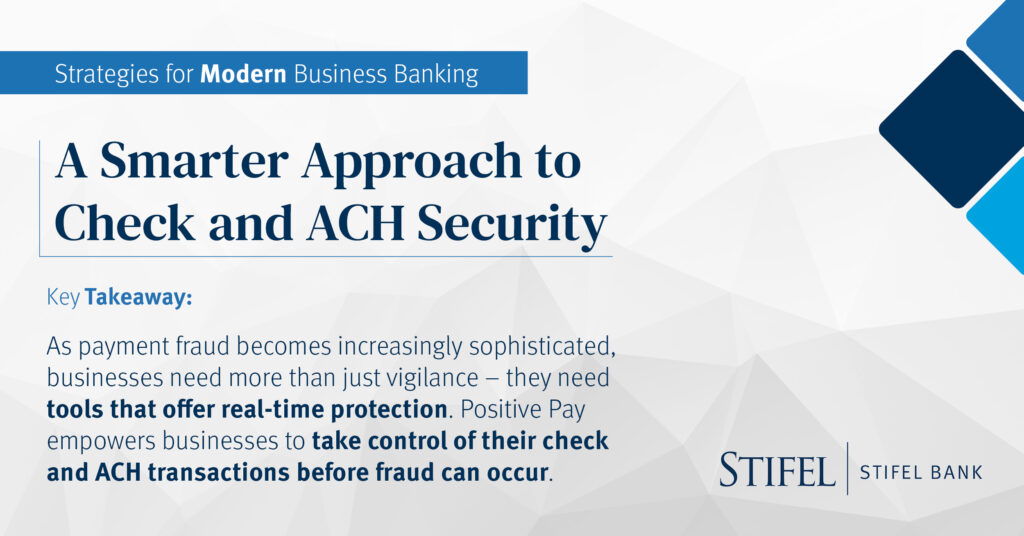How Positive Pay Protects Your Business: Check Fraud and ACH Fraud Prevention Explained
Stifel Bank Insights

In today’s environment, payment fraud is becoming more sophisticated. So how can businesses prevent check fraud and ACH fraud in real time? To achieve this, businesses need more than vigilance—they need tools that stop fraud before it happens. That’s where Positive Pay comes in.
Positive Pay is a fraud-prevention service offered by many banks and financial institutions. It gives businesses real-time control over check payments and ACH transactions, making it much harder for counterfeit, altered, or unauthorized payments to slip through.
What Is Check Positive Pay and How Does It Work?
Check Positive Pay is a fraud-prevention service offered by banks to protect businesses from check fraud. It helps stop forged, altered, or counterfeit checks before they clear.
Here’s how Check Positive Pay works:
- Issuing Checks: The business gives the bank with a list of checks it has issued, including check number, amount, and payee.
- Verification: When a check is presented for payment, the bank compares it against the list provided by the business.
- Flagging Suspicious Checks: If any details don’t match, the check is considered suspicious and flagged as an exception.
- Decision Making: The business is notified of the exception and can decide whether to process or return the check.
By requiring every check to be verified against the company’s own records, Check Positive Pay significantly reduces the risk of fraudulent payments being processed.
What Is ACH Positive Pay and How Does It Prevent ACH Fraud?
ACH Positive Pay is a fraud-prevention service offered by banks to protect businesses against unauthorized electronic debits. ACH (Automated Clearing House) payments are widely used for vendor payments, payroll, and recurring bills—but they’re also a target for fraud. Without controls, it’s easy for an unauthorized debit to slip through.
ACH Positive Pay solves this by allowing businesses to decide which transactions are permitted to post to their accounts. Companies provide their bank with details such as approved vendors (via Originator IDs), transaction amounts, or spending limits. The bank then uses this list as the standard for screening all incoming ACH activity, enabling the business to effectively manage and monitor transactions before they occur.
Here’s how ACH Positive Pay works:
- Authorize Transactions: The business gives the bank a list of approved ACH payments, including originator IDs, amounts, and any limits imposed.
- Monitor Activity: The bank reviews each incoming ACH debit against the approved list.
- Trigger Alerts: If a transaction doesn’t match, it triggers an alert, and the business decides whether to approve or reject it.
By combining authorization, monitoring, and alerts, ACH Positive Pay creates a strong defense against ACH debit fraud — preventing unauthorized payments before they impact cash flow.
Let’s explore the key benefits of implementing Check and ACH Positive Pay.
Top Benefits of Positive Pay
1. How Does Positive Pay Prevent Fraud?
The biggest advantage of Check and ACH Positive Pay is fraud prevention. By verifying every check and ACH debit against a list of authorized payments, businesses can stop unauthorized or altered transactions before they post. This proactive protection safeguards company funds and reduces financial losses.
2. How Does Positive Pay Improve Accuracy?
Positive Pay systems automate the verification process, minimizing the errors that come with manual check handling. Only legitimate transactions are approved, while discrepancies and suspicious activity are flagged instantly. This improves accuracy and reduces costly mistakes.

3. How Does Positive Pay Increase Control?
With Positive Pay, businesses gain greater control over daily transactions. Companies can set rules for payments—such as transaction amount, payee, or date. Any transaction that falls outside these parameters triggers an alert, allowing businesses to review and approve or deny the payment. This level of control helps maintain financial integrity and prevents unauthorized access to company accounts.
4. How Does Positive Pay Improve Cash Flow Management?
By ensuring that only authorized transactions are processed, Positive Pay gives businesses greater predictability in their cash flow. When payments are verified before clearing, companies avoid unexpected debits or fraudulent withdrawals that can disrupt daily operations. This stability allows leaders to plan and allocate resources with more confidence, supporting financial stability and long-term operational efficiency.
5. How Does Positive Pay Save Money?
Although many banks charge fees for Positive Pay, the service often delivers a net savings. Preventing just one fraudulent transaction can save thousands in direct losses, not to mention the hidden costs of legal recovery, staff time, and reputational damage. By reducing both fraud risk and processing errors, Positive Pay helps businesses protect their bottom line and avoid costly disruptions that far outweigh the service fees.
6. How Does Positive Pay Enhance Reputation?
Fraud prevention is not only about protecting money—it also protects trust. By implementing safeguards like Check Positive Pay and ACH Positive Pay, businesses send a clear signal that they take financial security seriously. This proactive stance strengthens credibility with clients, partners, and stakeholders, reinforcing the company’s reputation as a responsible and reliable organization. In industries where trust is critical, this can become a real competitive advantage.
Why Positive Pay Matters
Check and ACH Positive Pay provide businesses with a complete solution to strengthen financial security, accuracy, and control. By adopting these services, companies can protect their assets from fraud, maintain healthier cash flow, and reinforce a reputation for financial integrity. Ultimately, choosing Positive Pay is a strategic investment in safeguarding your organization’s financial future.
Ready to take the next step in protecting your transactions? Connect with your Stifel Relationship Team to learn how we can put these tools to work for your business today.
Written by
Related Insights
Other articles designed to help you along your financial journey.




